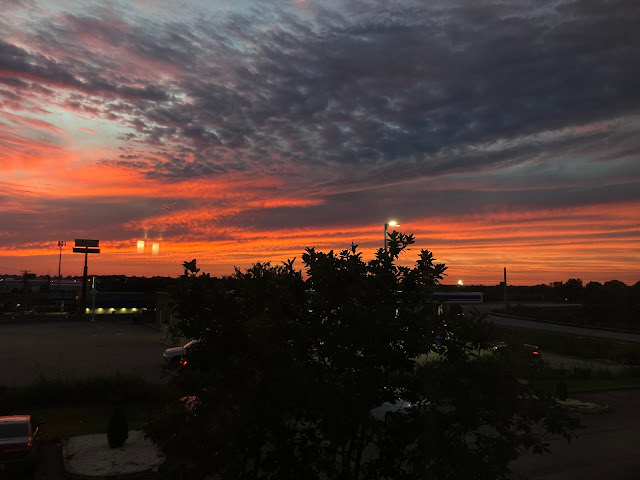The plan had been to spend one more day in New Bern, meet some old cruising friends for dinner, blow that pop stand the next morning and head to Oriental. But this morning's check of the weather suggested that today was the day for making good our escape. A few phone calls later and new plans were made for having the car catch up to us. With goodbyes said and hands shaken with the folks at Duck Creek (who have been as helpful as they could be for the last year) we headed down the dock to get underway for the first time in just shy of 4 years.
 |
| First sunrise on First Light. And a beautiful first light it was. One of the reasons we love the boat name and didn't change it. |
We scurried around trying to remember all the “heading out” chores that needed done, and to figure out which ones apply to trawlers. Obviously uncovering the sails and running the sheets and halyards wouldn't be necessary. Engine oil checks? Yep, x 2 though all the fluids were changes yesterday so that seemed redundant. Still, Deb suggested I look over the engine room anyway. I did: and put away the fan that had been left in there, stowed a half bottle of coolant sitting by the port engine, picked up some stray wiring, and moved a tool box back to where it belongs. Pre-engine start engine room check is now on the departure “must do” list. Then we talked over how we were going get out of the slip, down the creek and into the Neuse River. It has been a while since we reviewed nautical charts.
 |
| Painting the stripe is very very high up on the Captain's to-do list. |
When we couldn't come up with anything else needing done, I fired up the engines(!) while Deb pulled in the lines. A few bumps forward with the shifter levers, a few bumps back, and we cleared the dock without much ado. It was a slow and careful crawl down the creek as, along with the gen-set, the depth gauge that had worked during the sea trial stayed dark and dead in the panel. First Light draws less than four feet, but it is still spooky poking along without knowing just how much water is under the keel. A cool thing was that the upper chart plotter, which didn't work yesterday, lit up this morning without hesitation. RADAR! For the first couple of miles the helm felt very weird. Hydraulic steering takes a little getting used to. What took zero time to get used to was bringing the auto-pilot on line and just punching in the required headings. At some point we will figure out how to make it track a route, but for now, after the years of wrestling Kintala's wheel for hours at a time, heading hold was more than enough of a giggle.
The Neuse taught us some pretty harsh lessons in the past. More than once we limped into Oriental beat up, broken, and looking for a place to hide. But today? Today was as perfect a day as one could have for first trip in a new-to-us boat. Traffic was light, as were the winds. The slightest swell rolled under the bow while wavelets from the port side didn't move the boat at all. After the truncated, rigging-blocked view from the aft end of Kintala, the expanse of water visible over the bow of First Light was nothing short of amazing. At one point a King Pelican took flight off our bow. The only thing missing was a visit from a dolphin, welcoming us home. The hours strolled by as some of the very best we have ever enjoyed on a boat. It was hard to grasp that we made it, that we were back on the water and moving at our own pace.
Back in the day, when a marina came into view, the adrenaline started to flow and the brow started to furrow. Getting Kintala onto anything but a face dock in a calm wind was far more luck than skill. As great a sailing boat as she was, docking was a nightmare. Backing into a slip was generally completely out of the question. In fact, as I sit writing this and looking at the boats around us (with one exception) the only ones stern-to are trawlers and catamarans. And I know why. Deb talked me into the marina and down the right fairway. We counted slips and spotted an empty one that looked to be ours between a Lagoon 40 Cat and that stray sailboat parked stern-to. Today there was a little wind blowing but it made no difference. First Light obeyed my commands without complaint, eased back into the slip and stopped right where I asked. Deb set a couple of lines to hold the boat still, I shut off the engines, we set fenders, added lines, hooked up to shore power, and called our first trip a complete success.
For the next couple of days we will enjoy one of our favorite towns from our previous cruising days, get some more work done on the boat, and marvel at just how lucky we have been.
The reflections from the sun on the water in the cabins is one of the things I missed most
when we returned to land. It's amazing how much these little things all add up to make
this life as wonderful as it is.

















































